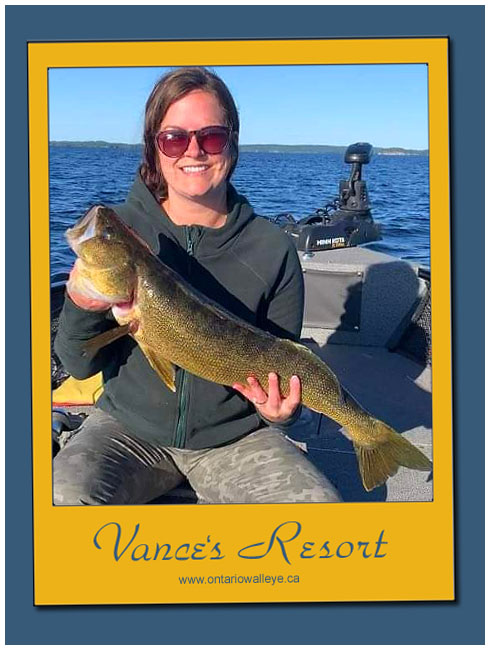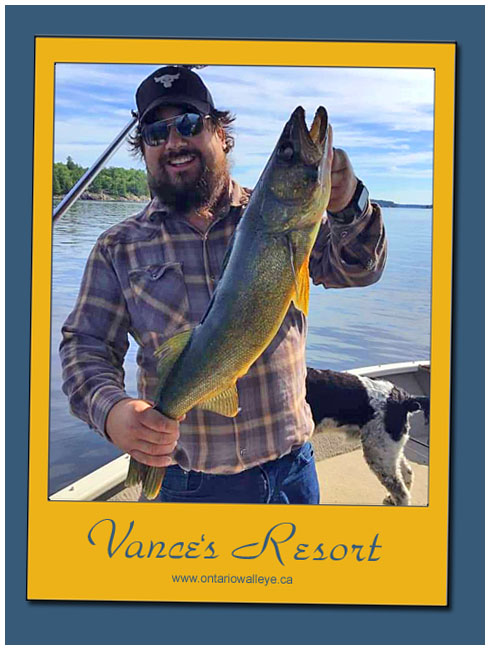
 The Spanish River is well known for not only having high populations of Walleye but big trophy Walleye. Our location is remote and far enough north that pollution or over-fishing is not a factor. But, we are far enough south that we have a long growing season, which has resulted in a river with some of the biggest Walleyes in Ontario. The thousands of shoals, islands, perfect spawning grounds and high bait forage also contribute to the incredible Walleye fishing.
The Spanish River is well known for not only having high populations of Walleye but big trophy Walleye. Our location is remote and far enough north that pollution or over-fishing is not a factor. But, we are far enough south that we have a long growing season, which has resulted in a river with some of the biggest Walleyes in Ontario. The thousands of shoals, islands, perfect spawning grounds and high bait forage also contribute to the incredible Walleye fishing.
Walleyes in our area taste great. The meat is very lean and they cook up white and fluffy. Many of our guests go out in the morning and catch dinner and then spend the rest of the day fishing for the multiple species of game fish that our water system has to offer.
Walleye average about 2 pounds in our area but many bigger Walleyes over 5 pounds are caught and released on a regular basis. We do ask that guests release any Walleyes over 3 pounds as they are the breeding stock and do not taste as good as the smaller 2-pounders, which are the perfect eating size. This will give everyone the chance to catch good numbers and keep our Walleye fishery healthy.
• View Regulations for the Spanish River (zone 10 - Adobe .pdf)
• View Regulations for North Channel & Georgian Bay (zone 14 - Adobe .pdf)
• View Big Map of North Channel
 Download Adobe .pdf Reader for Free
Download Adobe .pdf Reader for Free
1/4 oz. and 1/8 oz. jig heads: The color of the jig heads is not that important. The color of the rubber or bait you attach makes the difference. In the spring or at night, the Walleyes are in shallow water so you would want to use a lighter jig like a 1/8 oz or even smaller. During the day or in the Summer when it's warm and sunny, the Walleyes go deeper so you may want to use a heavier jig like a 1/4 oz.
 Twister Tails: Salted or un-scented - 2 inch to 4 inch single and double tail
Twister Tails: Salted or un-scented - 2 inch to 4 inch single and double tail
In the spring, the hot colors are white, bright yellow, bright red and black. As Spring turns into Summer, you will find that red and bright yellow slow down as good colors. Black and white always works but you should try a dark smoky yellow or a transparent green as the water warms up.
Many people believe that bright colors work in the Spring because the Walleye are still in protection mode over their spawning grounds and that they hit your jig on the act of defending and not eating.
Bounce On Bottom: Everyone seems to have their own style of jigging and when the Walleyes are hitting good, they go after any movement. Sometimes the Walleyes get lazy and they sit on bottom like they are sleeping. When this happens, try to make little tiny jig motions. Let your jig sit on the bottom and only jig it forward about 2 or 3 inches. Make sure your jig moves very slowly. The Walleyes will think it's a big bug or something on the bottom and they will hit it. I have been in situations where we did not even jig. We just dragged the jig on the bottom. This is not a good thing to do in thick weeds or a really muddy bottom but if there is a sand, gravel or rocky bottom, this technique works quite well.
Rapalas or Thunder Sticks: In the Spring, the best way to catch a big Walleye is to troll along the shoreline just before dark or at day-break with a Rapala or Thunder Stick. A 3 or 4 inch Original Floating Rapala or a Junior Thunder Stick with a little touch of liquid fish scent will bring in the big ones.
Rapalas and Thunder Sticks are also good in the summer. You can fish for those suspended deep water Walleyes or troll shallow along weed beds and drop-offs.
In the Spring the best colors are red, chartreuse, blue and most of all "Fire Tiger". As Spring turns into Summer, silver and brown pick up as the other colors die off. The one color combination that works all year is "Fire Tiger". It's probably the best color combination every created.
Worm Harness: In the Summer when it gets hot out, many of the big trophy Walleyes go deep. In this case, you should try drifting really slowly in the deep water with a worm harness. To keep your worm harness off the bottom, many people use a three-way-swivel set-up which is used with Lake Trout techniques. Below is a diagram.